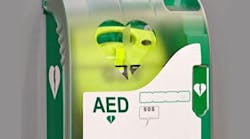One of the worst places to suffer a heart attack, stroke, or other medical emergency is in a commercial building. While EMTs can race to most buildings in minutes, it may take a while to find their way to the victim. Security officers prepared for medical emergencies can provide first aid and act on policies designed to speed EMTs to the scene.
Train Security Officers in First Aid
“Security officers should be able to identify medical emergencies, use the tools in a first aid kit, administer oxygen, operate an AED (automated external defibrillator), and administer CPR continuously,” says Bruce Evans, deputy chief with the Upper Pine River Fire Protection District and a member of the Board of Directors for the National Association of Emergency Medical Technicians.
Evans recommends inviting the American Heart Association or American Red Cross to teach a first aid course for the building staff, security officers, and tenants once a year.
If you want your security officers to have further training, look into a basic emergency medical responder course, continues Evans. These 40-hour courses cover AEDs, CPR, bone fractures, giving oxygen, and other emergency medical procedures more advanced than what general first aid courses teach.
Since 1995, Mike Fickes has contributed over 200 security articles to publications covering hotel, industrial, office, retail, critical infrastructure, and education. His interests include security management, policies, strategies, and technologies.
Provide First Aid SuppliesWhile OSHA requires employers to ensure that adequate first aid supplies are readily available, building security departments should store well-stocked first aid kits within several minutes of any place in the building. Here’s a list of some must-have items for commercial building first aid kits:
- AED
- Alcohol and antiseptics
- Bag valve mask and oral airway – the oral airway keeps the tongue off of the back of the throat while the bag valve mask provides rescue breathing
- Bandages and gauze
- Blanket and pillow
- Burn care materials
- Eyewash and eye-care products
- First aid instruments: scissors, tweezers, digital thermometer, blood pressure kit, ring cutter, splints, and tourniquets
- Hand sanitizer and rubber gloves
- Oxygen in a portable tank
- Pain, cold, and stomach upset relievers
Let the nature of the work in your building or the special tenant needs suggest other materials. OSHA refers employers to ANSI Z308.1-1978, which describes a generic workplace first aid kit.
Evans recommends locating AEDs around the building, noting that the standard in Las Vegas casinos is to have an AED within 90 seconds of any location inside.
Arrange for a contractor to come service the AEDs annually and refill oxygen tanks full. EMS agencies are typically more than happy to provide refills, Evans explains.
Set Policies and Procedures for Calling for Help
“When I worked in building security, we asked our tenants to call 911 in a medical emergency, direct the ambulance to the loading dock, and then to call security,” says Glen Kitteringham, CPP, principal consultant and president of Kitteringham Security Group, Inc.
Upon receiving a medical emergency call, Kitteringham dispatches one officer to the scene to help until EMTs arrived and second to the loading dock. This officer will lead emergency personnel to the freight elevator (which can accommodate a gurney) and guide them to the scene.
Procedures like this are necessary because of the way 911 calls are processed. At the 911 center, caller ID provides the building’s address if the call comes from the building system, but not if it comes from a mobile phone. Even with the building address, the EMTs may not know which elevator to use, what floor to go to, or where on the floor the patient can be found. Security officers must smooth the way.
Ask tenants to use the building’s landlines instead of mobile phones when calling 911. “Depending on the carrier and the location in the country, cell phones will sometimes connect to the wrong 911 center,” Evans says.
An accredited 911 center should also stay on the line and instruct callers in first aid. “You should know whether the 911 center your calls go to provide pre-arrival instructions,” Evans adds. “Ask if it is a certified emergency medical dispatch center. If the answer is no, ask if your calls can be routed to one that is certified.”
First aid training, quick access to the right tools, and clear procedures to speed the arrival of EMTs can tip the balance between life and death in an emergency. An empowered security team can make all the difference.


